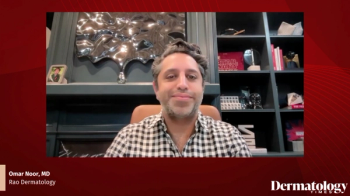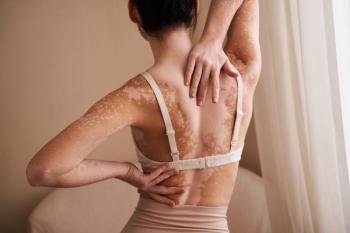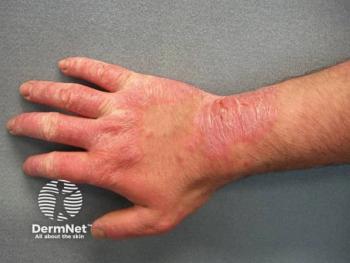
The Complex Clinical Landscape of Chronic Hand Eczema
Key Takeaways
- CHE is a heterogeneous, fluctuating skin disease with significant quality of life impacts, including socioeconomic burdens and psychiatric comorbidities.
- Differentiating CHE from atopic dermatitis involves recognizing distinct clinical features, inflammatory signatures, and exposure histories.
Christopher G. Bunick, MD, PhD, presents the significant challenges of CHE due to a lack of FDA-approved treatments, impacting patients' quality of life and requiring better therapeutic options.
Patients with moderate to severe chronic hand eczema (CHE) suffer from a pressing therapeutic gap as no FDA-approved treatments exist, and delgocitinib (LEO Pharma) has not yet been approved in the United States.
Dermatology Times: Can you provide an overview of CHE and why it can have a significant impact on quality of life?
Bunick: So chronic hand eczema, or CHE, is defined as hand eczema that occurs more than 3 months in a year or relapses twice or more in a given year. Another way to think about CHE is that it is a heterogeneous, long-lasting, fluctuating, inflammatory skin disease of the hands. It is thought of as a heterogeneous disease for two main reasons. First, its clinical presentations and morphologies can vary. And second, because there are commonly, more than 50% of the time, more than one etiologic or clinical subtype of CHE active in the same patient. Clinically, CHE is a fluctuating disease because the appearance and the severity of the CHE can vary over time too. The key signs and symptoms of CHE patients are itch, pain, bleeding, swelling of the hands, drying, thickening, and cracking of the skin, or fissuring, as well as erythema. I mentioned long-lasting earlier. And when these signs and symptoms last a long time, it definitely impacts quality of life of patients in several ways. It imparts a high socioeconomic burden due to altered ability to work. This can include increased sick leave, loss of productivity, loss of employment. It can also impact a patient's ability to perform domestic tasks. This can be due to exposure to irritants, for example, including also caring for children at home. It has been said that the quality of life impact from chronic hand can be equal or greater to the quality of life impairment seen in other serious chronic diseases. Lastly, I'll point out that there are three major psychiatric comorbidities seen in CHE patients, and those are depression, anxiety, and suicidal ideation. So if we step back and look at the big picture, why might we see that chronic hand eczema patients have such decreases in quality of life? Other than the face, what body part is visualized the most in society? And it's the hands. And so, I think that is why it's so important that we take care of our hands as much as we do our face.
Dermatology Times: What are some of the key differences between CHE and atopic dermatitis of the hand?
Bunick: It can be a real challenge to differentiate between chronic hand eczema due to atopic dermatitis versus CHE due to non-atopic dermatitis causes, but there are some clues that can help guide us. So if we first think about chronic hand eczema due to atopic dermatitis, this typically has a dorsal hand predilection. Few patients are going to present with pump licks, pulpitis, vesicular hand eczema, chronic and fissure hand eczema. Signs of AD may be typically found on other body parts, and that's a big clue. It's more often associated with asthma and allergic rhinitis. These are important questions to ask your patients. It also can be associated with a positive skin prick test, elevated specific IGE to air allergens, and/or elevated total IgE, and there tends to be a strong Th2 inflammatory signature. Now, if we contrast that with CHE, due to non-atopic dermatitis etiology, this CHE typically has a predominant palmar or interdigital presentation of the eczema. It contains the morphological subtypes, including pompholyx, vesicular hand eczema, chronic and fissured hand eczema, pulpitis, and up to a third of patients may have concomitant foot eczema, as well as some have nummular eczema. And some may even have a history of atopic dermatitis, which can certainly confuse the picture. It is often associated with occupational, domestic exposures due to skin irritants. This can be from excessive hand washing, rubber glove use. It can also be due to contact allergens, maybe in cosmetics, metals, glues. An exposure analysis may reveal skin irritant exposure and patch testing may reveal a contact allergy. Skin prick test may reveal a protein allergy. You can often see a mixed Th1, Th2, Th17, inflammatory signature. This can underlie the fact that multiple immune pathways may be involved in CHE due to non-AD etiology.
Dermatology Times: How does the lack of FDA-approved treatments in the US contribute to an unmet need in CHE?
Bunick: There are currently no treatments that are FDA approved in the United States for moderate to severe, chronic hand eczema. This imposes a number of challenges on us as providers and our patients. CHE can persist, despite topical corticosteroid treatment, and a proportion of patients do, in fact, relapse after corticosteroid use. There are a number of patients that suffer from corticosteroid phobia, and this can result in poor adherence or compliance with therapies. We know that long-term use of topical corticosteroids can lead to unwanted adverse events. This can include skin atrophy, rebound flares, and worsening of the chronic hand eczema signs or symptoms. Topical calcineurin inhibitors provide a steroid-sparing option, but their clinical use may be limited to the atopic subtype. Most patients, and this is really more than 75% of them, have reported in prior studies that they would prefer a steroid-free topical therapy if available. So therefore, what does this mean? It means that there's a high unmet need for a treatment that is efficacious, well tolerated, a non-steroidal topical and developed specifically for CHE to address that heterogeneity of the disease and provide a long-term disease control across all of the CHE subtypes.
Newsletter
Like what you’re reading? Subscribe to Dermatology Times for weekly updates on therapies, innovations, and real-world practice tips.



















